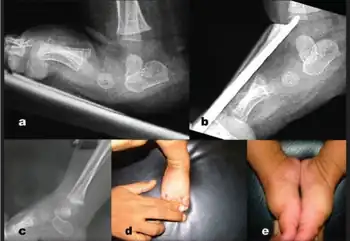Rocker bottom foot
| Rocker bottom foot | |
|---|---|
| Other names: Congenital vertical talus | |
 | |
| a) Lateral X-ray right foo with congenital vertical talus shows irreducible talonavicular joint. b) stress plantar flexion view shows fixed plantar flexed talus c) follow up X-ray- reduction of talonavicular joint with the track of k-wire in talar body d,e) photograph showing good correction of foot deformity | |
| Specialty | Medical genetics Orthopedics podiatry |
Unlike the flexible flat foot that is commonly encountered in young children,Rocker bottom foot or congenital vertical talus is characterized by presence of a very rigid foot deformity. The foot deformity in congenital vertical talus consists of various components, namely a prominent calcaneus caused by the ankle equines or plantar flexion, a convex and rounded sole of the foot caused by prominence of the head of the talus, and a dorsiflexion and abduction of the forefoot and midfoot on the hindfoot. It gets its name from the foot's resemblance to the bottom of a rocking chair.[1][2]
Types
There are two subcategories of congenital vertical talus namely idiopathic or isolated type and non-idiopathic type which may be seen in association with arthrogryposis multiplex congenital, genetic syndromes and other neuromuscular disorders.[1]
Cause
It can be associated with Edwards' syndrome (trisomy 18), Patau syndrome (trisomy 13), Trisomy 9 and mutation in the gene HOXD10.[3]
Diagnosis
The evaluation of Congenital vertical talus is done via the following[4]
- X-rays
- Forced dorsiflexion, and plantar flexion
Treatment
The treatment of congenital vertical talus can be broadly classified into conservative and surgical.[1][2][5]
Serial casting
The mainstay of management of congenital vertical talus is serial manipulative casting also known as the reversed Ponseti technique.[1] This technique involves gradual step-wise correction of the deformity usually on a weekly basis. In the event there is residual deformity or incomplete correction at the end of the serial castings, the orthopedic surgeon may resort to a minimally invasive surgery at the talo-navicular joint to achieve full correction. The results of the serial manipulative casting technique or reversed Ponseti technique are satisfactory especially if started shortly after birth.[1]
Classic soft tissue release
The classic or extensive soft tissue release involves a peri-talar release of tight or contracted ligamentous and capsular structures with the intent of achieving a complete repositioning or reduction of the talo-navicular joint. In that regard, various surgical techniques have been described.[reference] The extensive soft tissue release may be indicated in cases where the conservative methods - serial manipulative casting technique- have failed to achieved full correction of the deformity. However, the results are guarded.[6] All patients need close long term follow-up to allow for early detection of deformity recurrence. This is irrespective of the treatment modality used to attain deformity correction.
Naviculectomy or resection arthroplasty
Naviculectomy or simply navicular excision represents a form of mid-tarsal resection arthroplasty. It may be necessary to associate naviculectomy with limited soft tissue releases to address the remaining components of the deformity.[2][7][8][9][10] Naviculectomy has been practiced on ambulatory[2][7] and non-ambulatory (non-walkers) patients.[8]Naviculectomy is usually reserved for children with resistant or complicated forms of congenital vertical talus such as neglected, previously operated and recurrent cases. Naviculectomy may be indicated in the above resistant case of congenital vertical talus on the condition that a plantigrade foot is considered unlikely by the conservative serial casting methods. And on the condition that extensive soft tissue release is not expected to yield a satisfactory clinical and functional result.[2][7] Generally, naviculectomy is a more tissue-friendly procedure in contrast to the more aggressive classic and extensive peri-talar soft tissue releases. The clinical and radiologic results of naviculectomy are satisfactory on the short term,[2][10] and long term[9] follow-up.
References
- 1 2 3 4 5 Miller, Mark; Dobbs, Matthew B. (October 2015). "Congenital Vertical Talus". Journal of the American Academy of Orthopaedic Surgeons. 23 (10): 604–611. doi:10.5435/JAAOS-D-14-00034. PMID 26337950. S2CID 2282828.
- 1 2 3 4 5 6 El-Sobky, TA; Samir, S; Mahmoud, S (24 July 2019). "Naviculectomy for two ambulatory children with intractable congenital vertical talus: redefining the indications of an old technique". Journal of Pediatric Orthopedics. Part B. 29 (4): 387–391. doi:10.1097/BPB.0000000000000663. PMC 7255489. PMID 31356503.
- ↑ Gurnett CA, Keppel C, Bick J, Bowcock AM, Dobbs MB (September 2007). "Absence of HOXD10 mutations in idiopathic clubfoot and sporadic vertical talus". Clinical Orthopaedics and Related Research. 462: 27–31. doi:10.1097/BLO.0b013e31805d8649. PMID 17417092. S2CID 28900352.
- ↑ Agrawal, Udit; Tiwari, Vivek (2022). "Congenital Vertical Talus". StatPearls. StatPearls Publishing. Archived from the original on 7 March 2023. Retrieved 7 March 2023.
- ↑ van Bosse, Harold Jacob Pieter (December 2015). "Syndromic Feet". Foot and Ankle Clinics. 20 (4): 619–644. doi:10.1016/j.fcl.2015.07.010. PMID 26589082.
- ↑ Yang, Justin S; Dobbs, Matthew B (August 2015). "Treatment of Congenital Vertical Talus: Comparison of Minimally Invasive and Extensive Soft-Tissue Release Procedures at Minimum Five-Year Follow-up". The Journal of Bone and Joint Surgery. American Volume. 97 (16): 1354–1365. doi:10.2106/JBJS.N.01002. PMID 26290087. Archived from the original on 2022-11-08. Retrieved 2022-12-20.
- 1 2 3 Mosca, Vincent (2014). Principles and management of pediatric foot and ankle deformities and malformations (first ed.). Philadelphia: Lippincott Williams & Wilkins.
- 1 2 Laudrin, P.; Wicart, P.; Seringe, R. (September 2007). "Résection de l'os naviculaire pour déformation sévère du médio-pied de l'enfant". Revue de Chirurgie Orthopédique et Réparatrice de l'Appareil Moteur. 93 (5): 478–485. doi:10.1016/s0035-1040(07)90330-x. PMID 17878839.
- 1 2 Clark, MW; D'Ambrosia, RD; Ferguson, AB (September 1977). "Congenital vertical talus: treatment by open reduction and navicular excision". The Journal of Bone and Joint Surgery. American Volume. 59 (6): 816–24. doi:10.2106/00004623-197759060-00016. PMID 908706.
- 1 2 Robbins, H (October 1976). "Naviculectomy for congenital vertical talus". Bulletin of the Hospital for Joint Diseases. 37 (2): 77–97. PMID 1028515.
External links
| Classification |
|---|